The optical connector polishing films market is set to grow from USD 181.4 million in 2025 to USD 356.7 million by 2035, reflecting a steady CAGR of 7.0%. Over the first five years, from 2025 to 2030, the market exhibits moderate growth, expanding from USD 129.3 million to USD 181.4 million. During this period, annual increments are consistent, with values moving from USD 138.4 million in 2026, USD 148.0 million in 2027, USD 158.4 million in 2028, and USD 169.5 million in 2029.
The early phase of growth is largely attributed to the rising demand for optical connectors in telecommunications, data centers, and consumer electronics, alongside advancements in polishing film technologies.
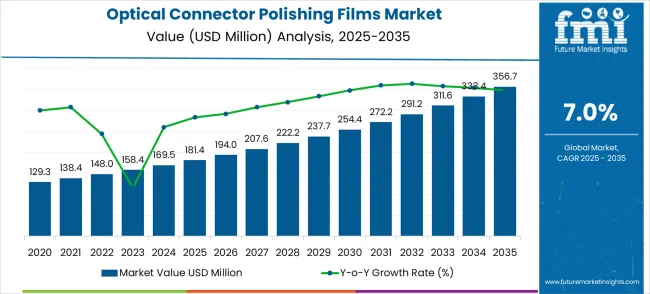
From 2030 to 2035, the market sees a more accelerated expansion, with values increasing from USD 194.0 million in 2031 to USD 356.7 million by 2035. Between 2032 and 2033, with values rising from USD 207.6 million to USD 222.2 million, and USD 237.7 million in 2034. The surge is driven by the increasing adoption of high-speed optical communication systems, fueled by the ongoing expansion of 5G networks and data center infrastructure.
Technological advancements in polishing film materials that enhance performance, coupled with growing demand for optical connectors across various industries, ensure a strong growth trajectory throughout the second half of the decade. By 2035, the market is expected to reach USD 356.7 million, driven by robust demand across various end-user applications.
| Metric | Value |
|---|---|
| Estimated Value in (2025E) | USD 181.4 million |
| Forecast Value in (2035F) | USD 356.7 million |
| Forecast CAGR (2025 to 2035) | 7.0% |
In the optical communication market, optical connector polishing films account for approximately 7-9% of the total market share. These films are essential for ensuring the smooth, precise surface of optical connectors, which is critical for high-speed fiber-optic communication systems. As demand for faster and more reliable communication networks, including fiber-optic technologies, continues to grow, so does the need for high-performance polishing films. In the telecommunications market, these films represent around 6-8%, driven by the ongoing expansion of 5G networks and the increasing requirement for high-quality connectors in telecom infrastructure.
In the data center market, optical connector polishing films contribute about 5-7% of the market share. As data centers scale up to meet the demands of cloud computing and big data, the need for reliable optical connectors becomes more critical. In the electronics market, which includes consumer devices like smartphones and computers, these films account for approximately 4-6% of the market, as optical connectors are increasingly used to support faster data transfer speeds and improve device performance. In the manufacturing market, optical connector polishing films hold a share of 3-5%, as industries continue to refine the quality of connectors for optical networks, automotive systems, and medical devices.
Market expansion is being supported by the increasing global demand for high-speed data transmission and the corresponding need for precision optical connections that can maintain ultra-low insertion loss and superior optical performance while providing reliable signal transmission across various telecommunications applications. Modern fiber optic manufacturers are increasingly focused on implementing polishing solutions that can achieve exceptional surface quality, minimize connection losses, and provide consistent performance in demanding network environments. Optical connector polishing films' proven ability to deliver superior surface finishing, enhanced optical clarity, and versatile application compatibility make them essential materials for contemporary fiber optic manufacturing and network installation solutions.
The growing emphasis on 5G network infrastructure and data center expansion is driving demand for optical connector polishing films that can support high-density installations, achieve consistent surface quality, and enable reliable performance in high-bandwidth applications with minimal signal degradation. Network equipment processors' preference for polishing materials that combine precision capabilities with operational efficiency and cost-effectiveness is creating opportunities for innovative optical connector polishing film implementations. The rising influence of cloud computing and edge networking trends is also contributing to increased adoption of polishing films that can provide advanced optical performance solutions without compromising connection reliability or signal quality.
The market is segmented by classification, application, and region. By classification, the market is divided into diamond, silicon carbide, alumina, silicon oxide, cerium oxide, and others. Based on application, the market is categorized into LC connector, MTP/MPO connector, SC connector, ST connector, and others. Regionally, the market is divided into North America, Europe, East Asia, South Asia & Pacific, Latin America, and the Middle East & Africa.
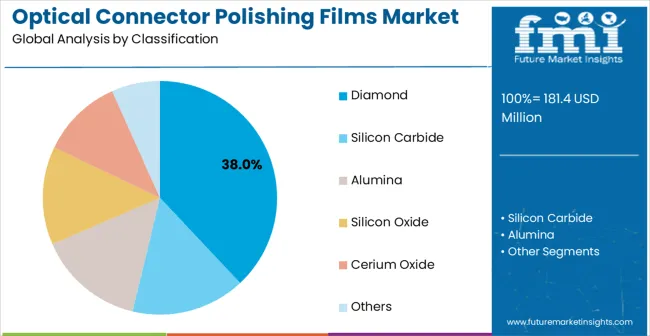
The diamond segment is projected to account for 38.0% of the optical connector polishing films market in 2025, reaffirming its position as the leading classification category. Fiber optic manufacturers increasingly utilize diamond polishing films for their superior cutting efficiency, proven abrasive performance, and convenience in precision surface finishing applications across high-performance optical connectors, telecommunications equipment, and data center installations. Diamond polishing technology's advanced material removal capabilities and consistent surface output directly address the industrial requirements for reliable optical performance and operational efficiency in demanding fiber optic manufacturing.
This classification segment forms the foundation of modern optical connector manufacturing operations, as it represents the abrasive material with the greatest precision capabilities and established market demand across multiple connector types and application requirements. Manufacturer investments in enhanced diamond polishing technologies and surface quality systems continue to strengthen adoption among fiber optic producers. With companies prioritizing consistent optical performance and proven surface finishing reliability, diamond polishing films align with both operational efficiency objectives and quality requirements, making them the central component of comprehensive optical connector manufacturing strategies.
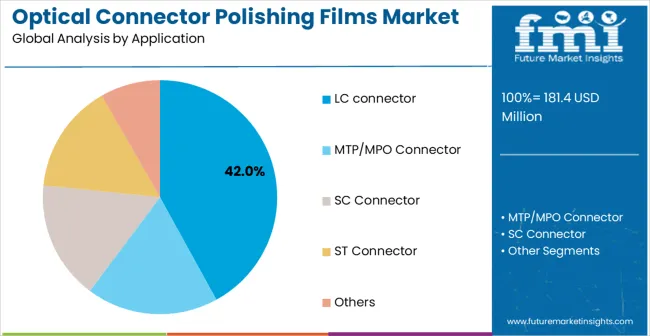
LC connector applications are projected to represent 42.0% of optical connector polishing films demand in 2025, underscoring their critical role as the primary application market for precision polishing materials in high-density fiber optic installations and data center connectivity solutions. LC connector manufacturers prefer optical polishing films for their exceptional surface quality, superior loss performance, and ability to achieve consistent optical interfaces while reducing manufacturing complexity and improving connection reliability. Positioned as essential materials for modern LC connector manufacturing, optical polishing films offer both precision advantages and performance benefits.
The segment is supported by continuous innovation in high-density connectivity development and the growing availability of specialized polishing technologies that enable premium LC connector production with enhanced optical performance and ultra-low insertion loss requirements. LC connector manufacturers are investing in advanced polishing systems to support high-volume production and quality assurance for next-generation data center and telecommunications applications. As bandwidth requirements become more demanding and connector density increases, LC connectors will continue to dominate the end-user market while supporting advanced polishing utilization and connectivity innovation strategies.
The optical connector polishing films market is advancing steadily due to increasing demand for high-performance fiber optic networks and growing adoption of precision polishing technologies that provide enhanced surface quality and optical performance across diverse telecommunications applications. The market faces challenges, including material cost fluctuations, technical skill requirements for optimal polishing, and the need for advanced manufacturing equipment investments. Innovation in automated polishing systems and AI-integrated quality control continues to influence product development and market expansion patterns.
The growing adoption of silicon carbide and alumina formulations with enhanced cutting characteristics is enabling polishing film manufacturers to produce premium optical connector polishing films with superior material removal rates, enhanced surface uniformity, and advanced precision capabilities. Advanced abrasive systems provide improved polishing efficiency while allowing more consistent processing and reliable output across various connector types and optical applications. Manufacturers are increasingly recognizing the competitive advantages of advanced abrasive capabilities for product differentiation and premium market positioning in demanding fiber optic segments.
Modern optical connector polishing film producers are incorporating automated polishing equipment and intelligent quality monitoring systems to enhance surface consistency, optimize polishing parameters, and ensure consistent performance delivery to fiber optic manufacturers. These technologies improve manufacturing precision while enabling new applications, including batch processing optimization and real-time surface quality monitoring. Advanced automation integration also allows manufacturers to support premium positioning and operational excellence beyond traditional polishing material capabilities.
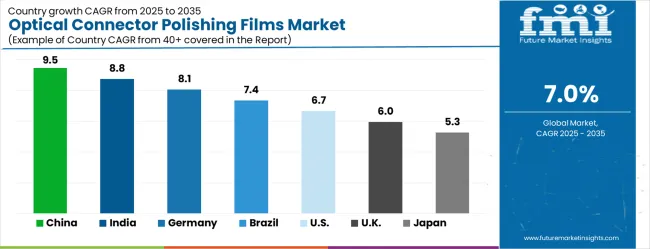
| Country | CAGR (2025-2035) |
|---|---|
| China | 9.5% |
| India | 8.8% |
| Germany | 8.1% |
| Brazil | 7.4% |
| USA | 6.7% |
| UK | 6.0% |
| Japan | 5.3% |
The optical connector polishing films market is experiencing strong growth globally, with China leading at a 9.5% CAGR through 2035, driven by the expanding telecommunications infrastructure industry, growing fiber optic manufacturing capabilities, and significant investment in 5G network development. India follows at 8.8%, supported by large-scale digital infrastructure development, emerging optical manufacturing facilities, and growing domestic demand for high-speed connectivity solutions. Germany shows growth at 8.1%, emphasizing technological innovation and premium optical component development. Brazil records 7.4%, focusing on telecommunications expansion and infrastructure modernization. The USA demonstrates 6.7% growth, prioritizing advanced manufacturing technologies and high-performance optical solutions. The UK exhibits 6.0% growth, emphasizing telecommunications capabilities and quality optical component adoption. Japan shows 5.3% growth, supported by precision manufacturing excellence and advanced optical technology innovation.
The report covers an in-depth analysis of 40+ countries with top-performing countries are highlighted below.
The optical connector polishing film market in China is projected to exhibit exceptional growth with a CAGR of 9.5% through 2035, driven by expanding telecommunications infrastructure development and rapidly growing fiber optic manufacturing capabilities supported by government 5G network deployment initiatives. The country's abundant optical manufacturing capacity and increasing investment in precision polishing technology are creating substantial demand for advanced surface finishing solutions. Major telecommunications equipment companies and optical component manufacturers are establishing comprehensive polishing capabilities to serve both domestic and international markets.
Revenue from optical connector polishing films in India is expanding at a CAGR of 8.8%, supported by the country's growing telecommunications infrastructure capacity, emerging optical manufacturing facilities, and increasing domestic demand for advanced connectivity technologies and fiber optic solutions. The country's developing optical supply chain and growing telecommunications industry are driving demand for sophisticated polishing capabilities. International technology providers and domestic manufacturers are establishing extensive production and distribution capabilities to address the growing demand for optical connector polishing films.
Demand for optical connector polishing films in Germany is anticipated to grow at a CAGR of 8.1%, supported by the country's advanced manufacturing industry, strong emphasis on technological innovation, and robust demand for high-performance optical solutions among quality-focused manufacturers. The nation's mature telecommunications equipment sector and high adoption of precision manufacturing technologies are driving sophisticated polishing capabilities throughout the supply chain. Leading manufacturers and technology providers are investing extensively in premium polishing development and advanced surface finishing methods to serve both domestic and export markets.
Sales of optical connector polishing films in Brazil is expected to expand at a CAGR of 7.4%, driven by expanding telecommunications infrastructure development, increasing network modernization patterns, and growing investment in fiber optic technology adoption. The country's developing telecommunications resources and modernization of network facilities are supporting demand for advanced polishing technologies across major deployment regions. Telecommunications operators and optical component companies are establishing comprehensive capabilities to serve both domestic connectivity centers and emerging infrastructure markets.
The optical connector polishing film market in the USA is set to grow at a CAGR of 6.7%, supported by the country's advanced telecommunications industry, emphasis on high-performance optical supply, and strong demand for sophisticated connectivity solutions among technology-focused companies. The USA's established optical manufacturing sector and technological expertise are supporting investment in advanced polishing capabilities throughout major technology centers. Industry leaders are establishing comprehensive quality management systems to serve both domestic and export markets with premium polishing solutions.
Demand for optical connector polishing films in the UK is growing at a CAGR of 6.0%, driven by the country's telecommunications industry, emphasis on quality optical adoption, and strong demand for high-performance connectivity solutions among established producers. The UK's mature telecommunications sector and focus on technology excellence are supporting investment in advanced polishing capabilities throughout major technology centers. Manufacturing companies are establishing comprehensive polishing systems to serve both domestic and international markets with quality optical solutions.
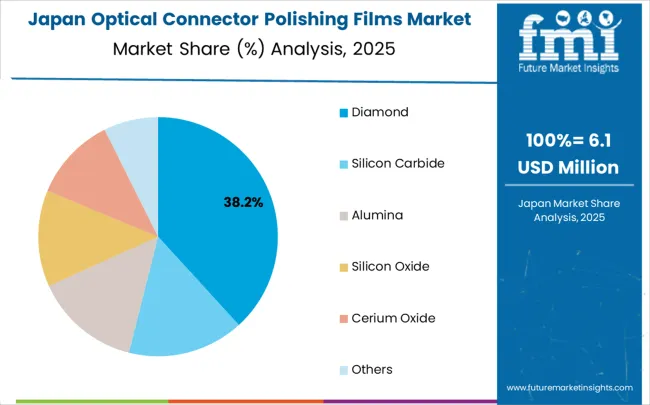
The optical connector polishing film market in Japan is expanding at a CAGR of 5.3%, supported by the country's focus on precision manufacturing excellence, advanced optical applications, and strong preference for high-quality connectivity solutions. Japan's sophisticated optical manufacturing industry and emphasis on surface precision are driving demand for advanced polishing technologies including diamond systems and high-performance finishing methods. Leading manufacturers are investing in specialized capabilities to serve optical component production, telecommunications equipment manufacturing, and precision polishing applications with premium optical offerings.
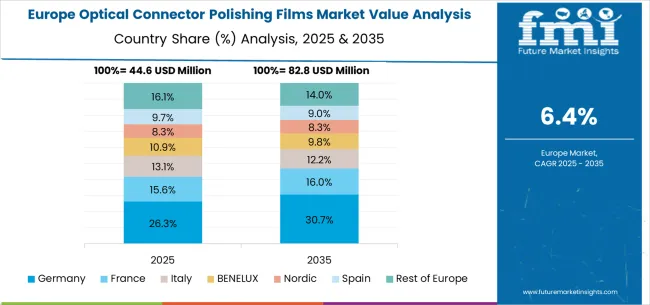
The optical connector polishing films market in Europe is projected to grow from USD 39.9 million in 2025 to USD 78.5 million by 2035, registering a CAGR of 7.0% over the forecast period. Germany is expected to maintain its leadership position with a 25.0% market share in 2025, declining slightly to 24.5% by 2035, supported by its strong optical manufacturing industry, advanced polishing facilities, and comprehensive telecommunications equipment supply network serving major European markets.
France follows with an 18.5% share in 2025, projected to reach 18.8% by 2035, driven by robust demand for optical connector polishing films in telecommunications manufacturing, data center applications, and precision optical component production, combined with established technology traditions incorporating advanced polishing materials. The United Kingdom holds a 16.0% share in 2025, expected to decrease to 15.7% by 2035, supported by strong telecommunications sector demand but facing challenges from competitive pressures and market restructuring. Italy commands a 14.0% share in 2025, projected to reach 14.2% by 2035, while Spain accounts for 12.0% in 2025, expected to reach 12.2% by 2035. The Netherlands maintains a 4.5% share in 2025, growing to 4.7% by 2035. The Rest of Europe region, including Nordic countries, Eastern Europe, Portugal, Belgium, Switzerland, and Austria, is anticipated to gain momentum, expanding its collective share from 10.0% to 9.9% by 2035, attributed to increasing adoption of advanced telecommunications equipment in Nordic countries and growing optical manufacturing activities across Eastern European markets implementing network modernization programs.
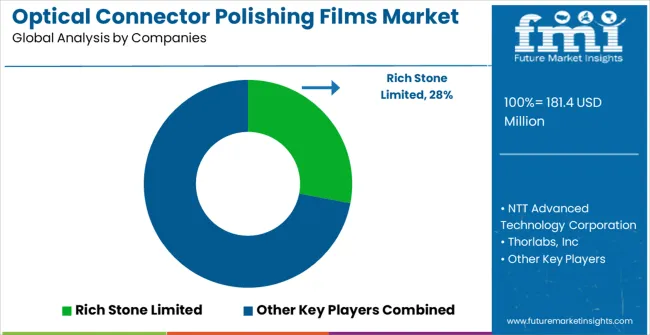
The optical connector polishing films market is characterized by competition among established abrasive material manufacturers, specialized optical component suppliers, and integrated polishing solution providers. Companies are investing in advanced abrasive technology research, surface quality optimization, automated polishing systems, and comprehensive product portfolios to deliver consistent, high-quality, and cost-effective optical connector polishing film solutions. Innovation in abrasive formulations, automated polishing equipment, and quality control systems is central to strengthening market position and competitive advantage.
Rich Stone Limited leads the market with a strong market share, offering comprehensive polishing solutions with a focus on telecommunications applications and precision surface finishing systems. NTT Advanced Technology Corporation provides specialized optical capabilities with an emphasis on high-performance connector applications and manufacturing efficiency. Thorlabs Inc delivers innovative optical solutions with a focus on research applications and product versatility. K&M Solutions Co specializes in polishing technology and advanced surface finishing solutions for optical markets. Mipox Corporation focuses on abrasive technology and integrated polishing operations. Krell Tech offers specialized optical connector polishing products with emphasis on precision applications and quality control.
| Items | Values |
|---|---|
| Quantitative Units (2025) | USD 181.4 million |
| Classification | Diamond, Silicon Carbide, Alumina, Silicon Oxide, Cerium Oxide, Others |
| Application | LC Connector, MTP/MPO Connector, SC Connector, ST Connector, Others |
| Regions Covered | North America, Europe, East Asia, South Asia & Pacific, Latin America, Middle East & Africa |
| Countries Covered | United States, Canada, United Kingdom, Germany, France, China, Japan, South Korea, India, Brazil, Australia and 40+ countries |
| Key Companies Profiled | Rich Stone Limited, NTT Advanced Technology Corporation, Thorlabs Inc, K&M Solutions Co, Mipox Corporation, and Krell Tech |
| Additional Attributes | Dollar sales by classification and application category, regional demand trends, competitive landscape, technological advancements in polishing systems, abrasive innovation, surface quality development, and manufacturing optimization |
The global optical connector polishing films market is estimated to be valued at USD 181.4 million in 2025.
The market size for the optical connector polishing films market is projected to reach USD 356.7 million by 2035.
The optical connector polishing films market is expected to grow at a 7.0% CAGR between 2025 and 2035.
The key product types in optical connector polishing films market are diamond, silicon carbide, alumina, silicon oxide, cerium oxide and others.
In terms of application, LC connector segment to command 42.0% share in the optical connector polishing films market in 2025.






Our Research Products

The "Full Research Suite" delivers actionable market intel, deep dives on markets or technologies, so clients act faster, cut risk, and unlock growth.

The Leaderboard benchmarks and ranks top vendors, classifying them as Established Leaders, Leading Challengers, or Disruptors & Challengers.

Locates where complements amplify value and substitutes erode it, forecasting net impact by horizon

We deliver granular, decision-grade intel: market sizing, 5-year forecasts, pricing, adoption, usage, revenue, and operational KPIs—plus competitor tracking, regulation, and value chains—across 60 countries broadly.

Spot the shifts before they hit your P&L. We track inflection points, adoption curves, pricing moves, and ecosystem plays to show where demand is heading, why it is changing, and what to do next across high-growth markets and disruptive tech

Real-time reads of user behavior. We track shifting priorities, perceptions of today’s and next-gen services, and provider experience, then pace how fast tech moves from trial to adoption, blending buyer, consumer, and channel inputs with social signals (#WhySwitch, #UX).

Partner with our analyst team to build a custom report designed around your business priorities. From analysing market trends to assessing competitors or crafting bespoke datasets, we tailor insights to your needs.
Supplier Intelligence
Discovery & Profiling
Capacity & Footprint
Performance & Risk
Compliance & Governance
Commercial Readiness
Who Supplies Whom
Scorecards & Shortlists
Playbooks & Docs
Category Intelligence
Definition & Scope
Demand & Use Cases
Cost Drivers
Market Structure
Supply Chain Map
Trade & Policy
Operating Norms
Deliverables
Buyer Intelligence
Account Basics
Spend & Scope
Procurement Model
Vendor Requirements
Terms & Policies
Entry Strategy
Pain Points & Triggers
Outputs
Pricing Analysis
Benchmarks
Trends
Should-Cost
Indexation
Landed Cost
Commercial Terms
Deliverables
Brand Analysis
Positioning & Value Prop
Share & Presence
Customer Evidence
Go-to-Market
Digital & Reputation
Compliance & Trust
KPIs & Gaps
Outputs
Full Research Suite comprises of:
Market outlook & trends analysis
Interviews & case studies
Strategic recommendations
Vendor profiles & capabilities analysis
5-year forecasts
8 regions and 60+ country-level data splits
Market segment data splits
12 months of continuous data updates
DELIVERED AS:
PDF EXCEL ONLINE
Optical Spectrum Analyzer Market Size and Share Forecast Outlook 2025 to 2035
Optical Extinction Analyzer Market Size and Share Forecast Outlook 2025 to 2035
Optical Character Recognition Market Forecast and Outlook 2025 to 2035
Optical Satellite Market Size and Share Forecast Outlook 2025 to 2035
Optical Imaging Market Size and Share Forecast Outlook 2025 to 2035
Optical Whitening Agents Market Size and Share Forecast Outlook 2025 to 2035
Optical Fingerprint Collector Market Size and Share Forecast Outlook 2025 to 2035
Optical Lens Materials Market Size and Share Forecast Outlook 2025 to 2035
Optical Microscope Market Size and Share Forecast Outlook 2025 to 2035
Optical Component Tester Market Size and Share Forecast Outlook 2025 to 2035
Optical EMI Shielding Adapters Market Size and Share Forecast Outlook 2025 to 2035
Optical Transmitter Market Size and Share Forecast Outlook 2025 to 2035
Optical Telephoto Lens Market Size and Share Forecast Outlook 2025 to 2035
Optical Lattice Clock Market Size and Share Forecast Outlook 2025 to 2035
Optical Grade Lithium Tantalate Wafers Market Size and Share Forecast Outlook 2025 to 2035
Optical Grade LiTaO3 Crystal Substrate Market Size and Share Forecast Outlook 2025 to 2035
Optical Brighteners Market Size and Share Forecast Outlook 2025 to 2035
Optical Liquid Level Sensor Market Size and Share Forecast Outlook 2025 to 2035
Optical Fiber Market Size and Share Forecast Outlook 2025 to 2035
Optical Communication and Networking Market Size and Share Forecast Outlook 2025 to 2035

Thank you!
You will receive an email from our Business Development Manager. Please be sure to check your SPAM/JUNK folder too.
Chat With
MaRIA